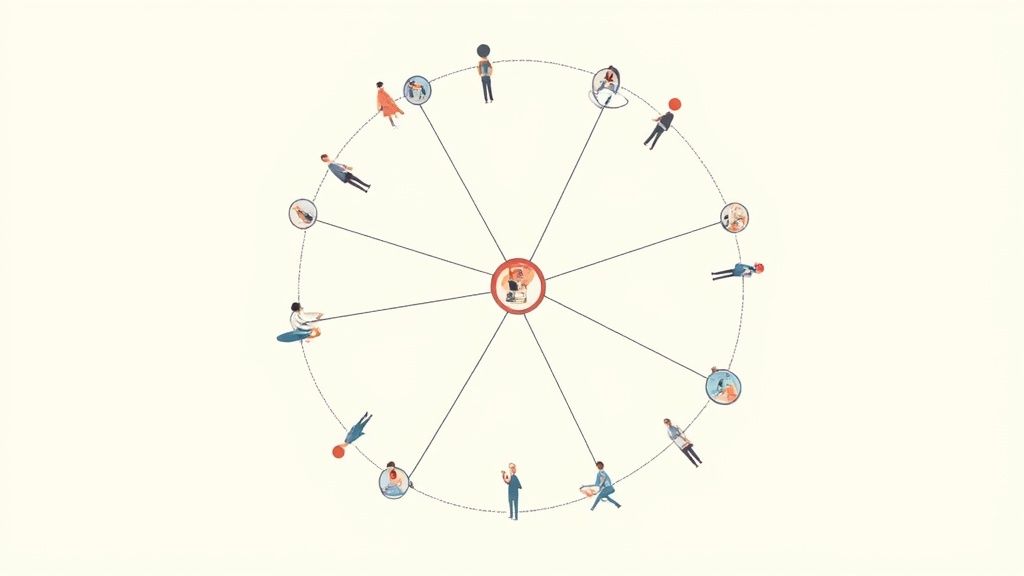10. Develop Knowledge Leadership and Governance
A knowledge management system without leadership is like a ship without a captain. It will drift aimlessly and likely run aground. To avoid this, one of the most vital knowledge management best practices is to establish clear leadership roles and a robust governance structure. This framework provides the strategic direction, accountability, and authority needed to embed knowledge sharing into your organisation’s DNA. It ensures your initiatives are not just one-off projects but a sustained, value-driving discipline.
This practice moves beyond simply hoping people will share what they know. It involves creating a formal structure with dedicated roles, decision-making frameworks, and defined responsibilities. For example, the World Bank’s sophisticated governance model includes a Knowledge Management Council and dedicated units to drive its global knowledge-sharing agenda. Similarly, pioneers like Larry Prusak at IBM and Leif Edvinsson, the world's first Chief Knowledge Officer at Skandia, demonstrated how dedicated leadership could transform intellectual capital into measurable financial performance and a powerful competitive advantage.
How to implement this practice.
Effective governance starts by giving knowledge management a seat at the strategic table. This means empowering leaders and creating a structure that connects centralised strategy with decentralised, on-the-ground execution. This ensures both high-level alignment and practical relevance across all business functions.
- Establish dedicated leadership. Appoint a Chief Knowledge Officer or a KM Lead with the authority and resources to drive the strategy. This role is crucial for securing executive buy-in and championing the initiative.
- Form a cross-functional steering committee. Include representatives from all major business units, such as IT, HR, Operations, and Sales. This ensures diverse perspectives are heard and fosters collective ownership.
- Create a clear charter. Document the purpose, scope, roles, responsibilities, and decision-making processes of your KM governance body. This charter provides clarity and prevents ambiguity.
- Balance centralisation and decentralisation. While the overall strategy should be centralised, empower local "knowledge champions" or subject matter experts within teams to manage and curate knowledge relevant to their specific domains.
Knowledge Management Best Practices Comparison
| Knowledge Management Approach |
Implementation Complexity 🔄 |
Resource Requirements ⚡ |
Expected Outcomes 📊 |
Ideal Use Cases 💡 |
Key Advantages ⭐ |
| Create a Knowledge Management Strategy Aligned with Business Goals |
High – requires comprehensive planning and leadership commitment |
Significant – involves governance structures and executive sponsorship |
Measurable business value, clear ROI, strategic alignment |
Organisations needing KM aligned with business goals and measurable impact |
Ensures direction, stakeholder buy-in, effective ROI measurement |
| Foster a Knowledge-Sharing Culture |
High – cultural change is gradual and effortful |
Moderate – involves leadership modeling and incentives |
Improved innovation, reduced silos, enhanced engagement |
Firms wanting to boost collaboration and innovation |
Builds trust, increases engagement, accelerates learning |
| Implement Effective Knowledge Capture and Documentation Processes |
Moderate – systematic but can be time-intensive |
Moderate to high – documentation tools and knowledge stewards |
Prevents knowledge loss, faster onboarding, reusable assets |
Organisations with high turnover or critical tacit knowledge |
Preserves knowledge, enables faster training, reduces expert dependency |
| Establish Communities of Practice and Expert Networks |
Moderate – requires coordination and ongoing support |
Moderate – dedicated time and collaborative platforms |
Accelerated peer learning, broken silos, network development |
Teams needing peer collaboration across functions/locations |
Enhances engagement, promotes expertise sharing, rapid knowledge transfer |
| Leverage Technology Platforms for Knowledge Management |
High – technology selection, integration, and training needed |
High – platform costs, maintenance, user support |
Scalable knowledge access, global collaboration, automation |
Enterprises requiring centralised and accessible KM technology |
Enables 24/7 access, AI recommendations, analytics-based insights |
| Implement Knowledge Retention Programs |
Moderate to high – requires structured capture and transfer efforts |
High – mentoring, interviews, succession planning |
Prevents knowledge loss, ensures continuity during transitions |
Organisations facing retirements or critical expert departures |
Maintains institutional memory, smooths succession, reduces risk |
| Measure and Evaluate Knowledge Management Impact |
Moderate – needs data collection and analysis systems |
Moderate – analytics tools and continuous feedback |
Demonstrated ROI, informed resource allocation, continuous improvement |
KM programs seeking validated value and performance tracking |
Builds credibility, guides decisions, mixes quantitative/qualitative metrics |
| Ensure Knowledge Quality and Accuracy |
Moderate – involves review processes and quality controls |
Moderate – expert reviewers, automated tools |
Trusted, accurate knowledge assets, higher adoption |
Environments requiring high-quality, reliable knowledge |
Reduces errors, builds trust, maintains standards and reputation |
| Integrate Knowledge Management with Business Processes |
High – requires process redesign and system integration |
Significant – change management and technical effort |
Seamless KM adoption, immediate value, continuous improvement |
Companies embedding KM into daily workflows |
Reduces workload, increases relevance, drives sustainable KM use |
| Develop Knowledge Leadership and Governance |
High – establishing leadership roles and governance structures |
Moderate to high – leadership time, committee resources |
Strategic oversight, accountability, consistent KM practice |
Organizations needing formal KM leadership and coordination |
Provides direction, accountability, cross-unit alignment |
Your Next Step: Building a More Capable Organisation
We have explored ten critical knowledge management best practices, from aligning your strategy with core business objectives to establishing strong governance. The journey from disconnected data points to collective intelligence is not just an IT project. It is a fundamental shift in culture, process, and leadership. Adopting these practices is the first step towards building a more resilient, adaptive, and ultimately more capable organisation.
The core takeaway is this. Effective knowledge management is less about having the right platform and more about enabling the right conversations and behaviours. It is the human element, the willingness to share, learn, and collaborate, that transforms a static repository of documents into a dynamic engine for growth. By focusing on creating a knowledge-sharing culture and integrating these practices into daily workflows, you empower your teams to solve problems faster, innovate more effectively, and avoid repeating past mistakes.
Turning Insight into Action
The path forward can seem complex, but it does not have to be. True transformation starts with people, not platforms. The principles we have discussed, such as fostering communities of practice and measuring impact, are not abstract ideals. They are tangible steps towards reclaiming time and making sharper, more informed decisions.
Consider these immediate next steps to bring these knowledge management best practices to life in your organisation:
- Start with a single pain point. Instead of attempting a complete overhaul, identify one significant bottleneck. Is it the onboarding process for new hires? Is it the inconsistent way sales teams access product information? Focus your initial efforts there to demonstrate value quickly.
- Identify your knowledge champions. Who are the natural connectors and experts in your organisation? Enlist them to lead a pilot community of practice. Their enthusiasm and expertise will be crucial for gaining early momentum and buy-in from their peers.
- Conduct a simple knowledge audit. Ask your teams two simple questions: "What information do you need to do your job that is hard to find?" and "What valuable knowledge do you have that you think others could use?" The answers will reveal your most critical knowledge gaps and opportunities.
Building Sustainable Capability
Ultimately, mastering knowledge management is about building digital sovereignty. It ensures the collective intelligence of your organisation remains within your control, continually refined and accessible, rather than locked away in silos or departing with key employees. This is about embedding a capability that lasts, creating an operational model that is truly sustainable because the knowledge and ownership stay with you.
Getting started can feel like a monumental task, especially when operational demands are already high. The key is to begin with an honest assessment of what is really happening in your organisation, not just what is documented on a process map. By focusing on people first, then process, we can help you cut through the operational fog and identify the real blockers. Our copilot approach uses scoped pricing and a shared Plans Portal to map the flow of information, pinpoint inefficiencies, and build a practical plan that delivers tangible results.
This is not about lengthy consulting engagements that produce more slide decks than results. It is about making your business genuinely better, one clear, impactful step at a time. The end goal is an organisation that learns faster, adapts quicker, and leverages its collective wisdom to achieve its most ambitious goals.
Ready to take the first step towards a more capable, knowledge-driven organisation?










